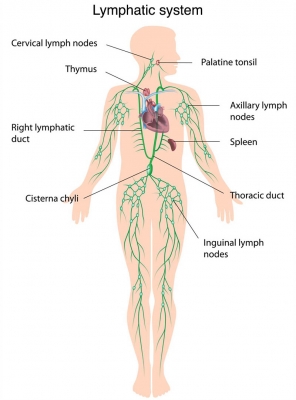
Tonsils
Deep inside the throat, the tonsils help to destroy germs that come into the body through the nose and mouth. Each tonsil is composed of tissue similar to lymph nodes, covered by pink mucosa (like on the adjacent mouth lining). Running through the mucosa of each tonsil are pits, called crypts.
The tonsils are part of the lymphatic system, which helps to fight infections.
Left subclavian vein
This drains blood from the left arm and collects lymph from the left side of the body and the lower half of the right side.
Right subclavian vein
This drains blood from the right arm and collects lymph from the upper half of the right side of the body.
Thoracic duct
The thoracic duct is the largest lymphatic vessel in the human body. Around 75% of the lymph from the entire body (aside from the right upper limb, right breast, right lung and right side of the head and neck) passes through the thoracic duct. Lymph drains into the left subclavian vein through this tube.
Ribcage
Rib cage, in vertebrate anatomy, basketlike skeletal structure that forms the chest, or thorax, and is made up of the ribs and their corresponding attachments to the sternum (breastbone) and the vertebral column. Red bone marrow in the ribs produces white blood cells.
Spleen
The largest organ in the lymphatic system, the spleen produces cells that help to fight infection. The spleen plays multiple supporting roles in the body. It acts as a filter for blood as part of the immune system. Old red blood cells are recycled in the spleen, and platelets and white blood cells are stored there. The spleen also helps fight certain kinds of bacteria that cause pneumonia and meningitis.
Cysterna chyli
This collects lymph from the lower half of the body before it goes up into the thoracic duct. It is an elongated, sac-like structure formed by the junction of a variable number of lumbar, intestinal, liver and descending intercostal lymphatic trunks. It extends 5-7 cm in the caudocephalad axis.
Lymph node
Lymph nodes are small lumps of tissue that contain white blood cells, which fight infection. They filter lymph fluid, which is composed of fluid and waste products from your body tissues. Lymph nodes also help activate your immune system if you have an infection. Lymph is processed and cleaned as it passes through lymph nodes.
Inguinal nodes
Lymph from the legs passes through these nodes. Lymph nodes are part of the body’s lymphatic system, which helps maintain fluid balance in the bloodstream, filters waste, and plays an important role in immune defense.
Lymph vessels
These tubes drain and transport lymph from body tissues. One of the main structural features of lymph vessels is their valves, which are semilunar structures attached to opposite sides of the lymphatic endothelium. Valves are found in larger lymph vessels and collecting vessels and are absent in the lymphatic capillaries.
Flowing fluid
The lymphatic system consists of a network of vessels (green), nodes, and organs, including the tonsils, spleen, and thymus gland. Unlike the vessels in the blood circulation system, lymphatics have no pump. Instead, lymph is pushed through the system by the movement of the surrounding muscles. Lymph eventually drains into two tubes, or ducts, in the chest, which carry the fluid back to the bloodstream.
Picture Credit : Google

